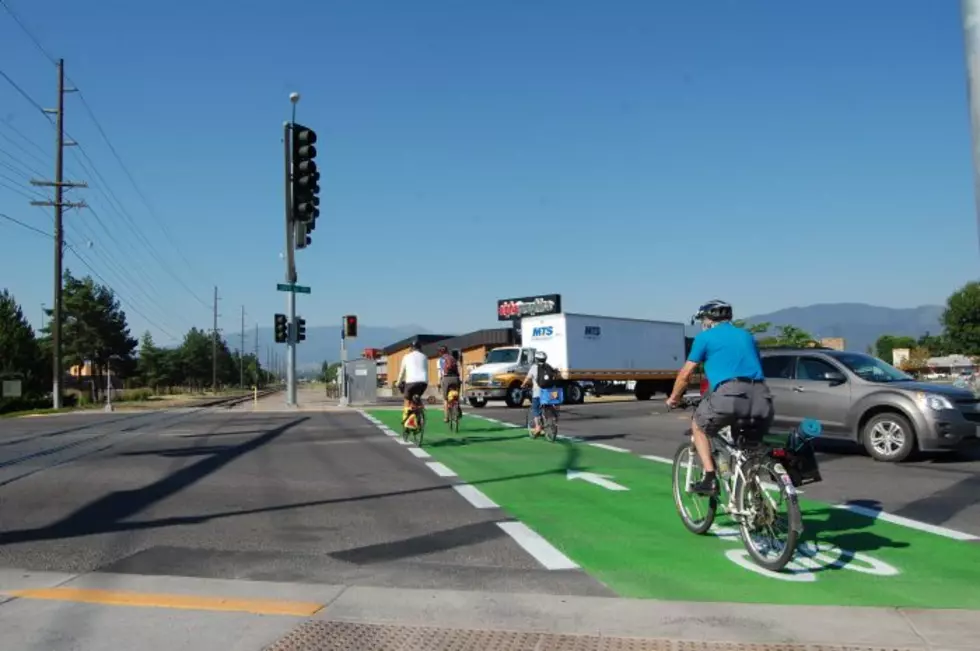
Sustainable Missoula: Transportation planning a key piece of climate-change mitigation
Sustainable Missoula is in the midst of a series of articles to build broader understanding of the 0/50/100 sustainability framework - Zero Waste, 50 percent sustainable trips, and 100 percent clean electricity for Missoula. This article is the second in a series on 50 percent sustainable trips. Read the first one here.
Climate Smart Missoula’s 2016 Greenhouse Gas Emissions Inventory states that transportation is the largest single source of local emissions, contributing 37 percent to Missoula’s total carbon footprint.
Eighty-seven percent of those emissions consist of on-road gasoline and diesel. (That’s 290,568 metric tons of CO2.) Given Climate Smart Missoula’s 0-50-100 sustainability framework (Zero Waste, 50 percent sustainable trips, and 100 percent clean electricity) for Missoula by 2035, biking, walking and using transit services has a huge role to play in building local resiliency.
With Missoula’s drive-alone rate at 70.1 percent, one of the most impactful changes we can make at a personal level is to choose sustainable modes of transportation. However, accessible, comfortable and convenient facilities are not available in all parts of Missoula, so we need to address this challenge through sustainable long-range planning for our transportation network.
Planning with sustainability in mind means ensuring that we provide for all modes of transportation in future transportation projects, in order to reduce our carbon footprint and protect natural resources. It is much easier for people to choose to bike, walk and ride the bus when facilities and multi-modal options are safe, comfortable and convenient for users of all abilities, ages and economic resources.
Sustainable planning also means maintaining existing facilities to protect and prolong investments while designing quality and long-lasting infrastructure that maximizes limited funding resources.
In cities all over the country, safe and well-connected pedestrian, bicycling and transit infrastructure clearly coincides with greater levels of walking and biking. Even locally, we see larger mode shares (or the number of people using a given form of transportation) of biking, walking and transit in neighborhoods and along corridors that offer high-quality bicycle and pedestrian infrastructure, shorter trip lengths and convenient transit lines. U.S. communities that offer walkable and bikeable spaces continue to be ranked among the top places in the country to live.
Missoula’s recently updated Long-Range Transportation Plan, Activate Missoula 2045, included a set of mode shift goals, such as reducing the percentage of drive-alone commutes by 50 percent by 2045. To achieve the reduction of drive-alone trips, the plan also calls for roughly tripling the percentage of bike, walk and transit trips over the next 25 years. Set through a yearlong public process, these mode split goals are certainly ambitious and may seem daunting to achieve. However, they are crucial to accommodate projected growth in the region while reducing our impact on air quality and natural resources.
Demands associated with improving bicycle and pedestrian infrastructure, adding and updating appropriate Americans with Disabilities Act (ADA) facilities, and improving transit options face challenges such as inadequate funding sources, a growing population, and continued aging of existing infrastructure. However, infrastructure associated with biking and walking is much cheaper per additional trip than vehicular infrastructure, while using far less space. Investments in biking and walking can lead to greater mobility for more people for less money.
At a planning level, shifting our transportation system to be less reliant on personal vehicles means focusing on better coordinating projects, completing connections in our non-motorized networks, finding additional funding opportunities, and increasing the effectiveness of existing funds through proper prioritization and coordination across the region.
In addition to the Long-Range Transportation Plan, Missoula has started this process by writing specific facility plans for each transportation mode. The Bicycle Facilities Master Plan shows how our current bike network requires new and improved connections and identifies projects that would open up much more of the community to people of all ages and abilities. Mountain Line also recently completed an update to their Strategic Plan that identifies opportunities to expand service hours and frequency, improving the transit system to be more accessible and convenient.
The Pedestrian Facilities Master Plan, currently awaiting City Council adoption, prioritizes sidewalk investments in neighborhoods and to destinations that will serve more people in a more equitable manner. All of these plans will continue to be evaluated and revised over time based on how their implementation contributes to our progress.
Our transportation plans have established a good framework to create and enhance our sustainable transportation system. Our existing and planned infrastructure will help folks make sustainable travel choices. Still, planning and infrastructure are just two of the pieces of the puzzle to achieve our sustainability goals. In the next installment of our sustainable transportation series we will look closer at how our education and encouragement programs also contribute to our success.
Tara Osendorf is Transportation Planner II with Missoula Metropolitan Planning Organization.
This Sustainable Missoula column is brought to you – via the Missoula Current – every Friday by Climate Smart Missoula and Home ReSource.
Upcoming Sustainability Events:
February 26. Winona LaDuke Lecture: “The Next Energy Economy: Grassroots Strategies to Mitigate Global Climate Change” – University Center Theater. 3:30 – 4:30 p.m.
February 28. Climate Change teach-in series kicks off with teach-in on Climate Change and Gender Oppression. UM's Payne Native American Center lobby. 12 – 1:30 p.m.
March 14. Climate Smart Missoula’s Monthly Meetup: Zero Waste is next month’s topic. Imagine Nation Brewing. 5 – 7 p.m.
View more climate and energy events via Climate Smart Missoula’s Calendar.
There are many more conservation events for 2019 HERE.
